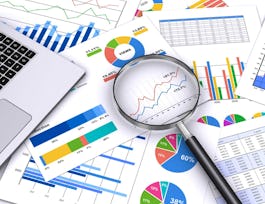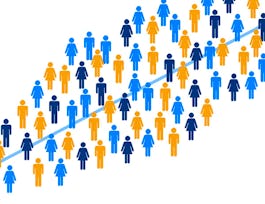This course introduces students to data and statistics. By the end of the course, students should be able to interpret descriptive statistics, causal analyses and visualizations to draw meaningful insights.


Data – What It Is, What We Can Do With It
This course is part of Data Literacy Specialization
Taught in English
Some content may not be translated

Instructor: Jennifer Bachner, PhD
7,529 already enrolled
Included with 
Course
(151 reviews)
Recommended experience
Skills you'll gain
Details to know

Add to your LinkedIn profile
13 quizzes
Course
(151 reviews)
Recommended experience
See how employees at top companies are mastering in-demand skills

Build your subject-matter expertise
- Learn new concepts from industry experts
- Gain a foundational understanding of a subject or tool
- Develop job-relevant skills with hands-on projects
- Earn a shareable career certificate


Earn a career certificate
Add this credential to your LinkedIn profile, resume, or CV
Share it on social media and in your performance review

There are 4 modules in this course
When most people think about using data, they quickly jump to considering the best way to analyze it with statistical methods. A good analysis, however, begins with a strong theoretical framework. A good theory will guide the collection of data, selection of appropriate statistical methods and interpretation of the results. Further, the theory will determine what kind of research design is needed, such as an observational study or experiment. This module will focus on the development of high-quality theories that can be used to guide descriptive, causal and predictive inference.
What's included
4 videos3 readings1 quiz1 discussion prompt
Establishing causality is frequently the primary motivation for research. Policymakers often want to understand how the implementation of a new program or other policy tool will affect an outcome of interest. Will smaller class sizes increase student learning? Will the implementation of stricter background checks for gun buyers reduce gun violence? Biomedical researchers often want to understand whether a new medicine will improve a disease outcome. Will taking a drug improve life expectancy, or even cure the disease under study? To answer these and similar questions, analysts must develop research designs that are appropriate for causal inference. Estimating a causal effect is challenging, yet it is essential to understand the impacts of a policy, medicine or any other kind of intervention.
What's included
4 videos3 readings4 quizzes
Over the next four lessons we'll begin to make sense of raw data. Staring at raw data, such as a spreadsheet, does not reveal much of anything about the key takeaway points. Consider a variable such as a survey question that asks about the level of discrimination in the U.S. (where the answer choices are "a lot," "some," "only a little," "none at all," and "don't know"). Reading the raw data does not tell you about the average respondent or the distribution of responses among the possible answer choices. To better understand the shape of the distribution, we can calculate measures of central tendency, measures of spread and characterize the data's dispersion. These summary statistics allow a researcher to draw some simple yet powerful initial conclusions about what the data tell us in a real-world sense.
What's included
4 videos5 readings4 quizzes
Edward Tufte, a world-renowned expert of data visualization, once said, "There is no such thing as information overload. There is only bad design." When communicating the results of an analysis, and particularly when trying to persuade an audience, a picture is truly worth a thousand words. A well-designed graph can leverage either a small or large amount of data to make a convincing argument. Data visualizations highlight specific points about the underlying information and enable the viewer to draw insights that are nearly invisible when staring at the numbers alone. In short, to be a good at communicating with data, you must become skilled at visualizing data.
What's included
3 videos4 readings4 quizzes
Instructor

Offered by
Recommended if you're interested in Probability and Statistics

Johns Hopkins University

Johns Hopkins University

Johns Hopkins University

Johns Hopkins University
Why people choose Coursera for their career




Learner reviews
Showing 3 of 151
151 reviews
- 5 stars
71.52%
- 4 stars
21.19%
- 3 stars
4.63%
- 2 stars
1.32%
- 1 star
1.32%
New to Probability and Statistics? Start here.

Open new doors with Coursera Plus
Unlimited access to 7,000+ world-class courses, hands-on projects, and job-ready certificate programs - all included in your subscription
Advance your career with an online degree
Earn a degree from world-class universities - 100% online
Join over 3,400 global companies that choose Coursera for Business
Upskill your employees to excel in the digital economy
Frequently asked questions
Access to lectures and assignments depends on your type of enrollment. If you take a course in audit mode, you will be able to see most course materials for free. To access graded assignments and to earn a Certificate, you will need to purchase the Certificate experience, during or after your audit. If you don't see the audit option:
The course may not offer an audit option. You can try a Free Trial instead, or apply for Financial Aid.
The course may offer 'Full Course, No Certificate' instead. This option lets you see all course materials, submit required assessments, and get a final grade. This also means that you will not be able to purchase a Certificate experience.
When you enroll in the course, you get access to all of the courses in the Specialization, and you earn a certificate when you complete the work. Your electronic Certificate will be added to your Accomplishments page - from there, you can print your Certificate or add it to your LinkedIn profile. If you only want to read and view the course content, you can audit the course for free.
If you subscribed, you get a 7-day free trial during which you can cancel at no penalty. After that, we don’t give refunds, but you can cancel your subscription at any time. See our full refund policy.

